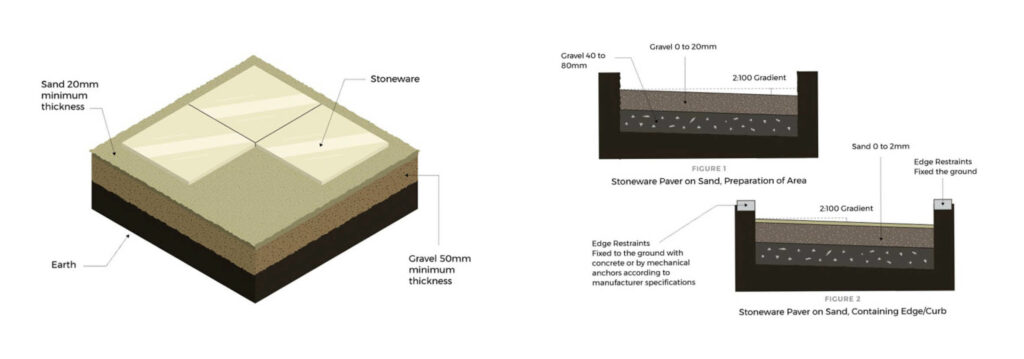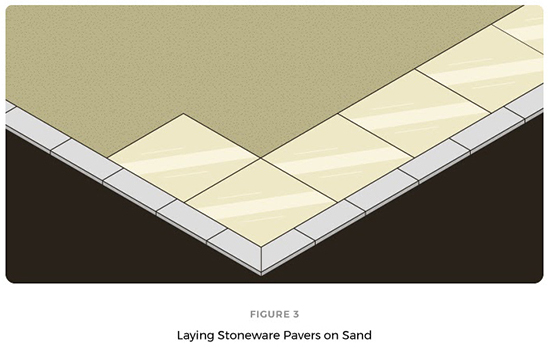Stoneware and Porcelain Paving Over Sand

Porcelain is a known material made of cutting edge technology and adds visual appeal to any home.
Porcelains are manufactured through a process known as vitrification. This process combines natural raw materials such as sand, quartz, and clays into a single element by melting them all together.
After vitrification, the porcelain is cooked at temperatures of 1230℃ and higher, resulting in exceptional strength and durability.
Stoneware and Porcelain Tile
| Width | 60cm | 600mm |
| Length | 60cm | 600mm |
| Thickness | 2cm | 20mm |
| Weight per piece | 47kg | |
| Weight per pack | 2.78 |
Colour Range
Our Stoneware and Porcelain tiles are available in a wide range of colours and textures, allowing you to create different patterns but still achieving the appearance of natural stone. You can create different themes and landscape designs with our pavers.
Advantages of Stoneware
Stoneware pavers have a lot to offer aside from its visual appeal, making it a favourite among homeowners.
Strength
Popular for their durability and strength.
Colour Durability
It has a permanent colour that will not fade.
Easy Installation
Quick and easy installation but still exudes a professional look.
Easy to Clean
Quickly clean spills, stains, or dirt simply with any household cleaner or other selected cleaning agents, such as Green Acid which is available through selected APC stores. You may even use a pressure washer, depending on the installation method used*.
Stylish
Can suit any home decor for both indoor and outdoor use.
Stain Resistant
Our pavers and tiles resist moss, dirt, mould, and other staining.
Slip-resistant
The structured texture creates a slip-resistant surface, making it safe to use around pools or in wet climates.
Salt and acid-resistant
The dense, durable structure of our Stoneware porcelain pavers makes them salt and acid resistant, ideal for pool surrounds and coastal applications.
Installing Stoneware and Porcelain Pavers
APC Stoneware and Porcelain pavers can be installed DIY style. With our easy-to-follow guide, you will be able to finish your project over the weekend.
Applications
APC brings you a complete guide on installation that is suitable for outdoor surfaces and all types of soil.
Uses
- Patio
- Courtyards
- Pathways
- Pool area
- Driveway
- Commercial area
*Note: APC Porcelain pavers should be subjected to low-pressure washers only, using a maximum of 1600pst or less. Take care when pressure washing to prevent damage to the grout, particularly the adhesive used during installation. Re-sanding of the joints might become necessary after power washing if the porcelain was installed with sand or polymeric sand joints.
Check our Stoneware and Porcelain pavers to see if they are applicable for the installation type you need.


| Installation Type | ||
|---|---|---|
| Installation location | Conventional rubble & sand base | Adhesive method on reinforced concrete base |
| Garden* | Yes | Yes |
| Courtyard | Yes | Yes |
| Patio* | Yes | Yes |
| Footpath* | Yes | Yes |
| Terrace* | Yes | Yes |
| Swimming Pool* | Yes | Yes |
| Stepping Stones | Yes | Yes |
| Driveway** | No | Yes |
| Commercial Areas** | No | Yes |
*The garden, courtyard, patio, footpath, terrace and swimming pool bear only pedestrian and bicycle load, never vehicular loads.
**The driveway and commercial area provide only light vehicular load.
Stoneware and Porcelain can be laid in two methods:
1. On a conventional rubble, sand paving base.
2. Adhesive method fixed to a reinforced concrete base
Cutting Pavers
We recommend using a quality powered saw even when you only need to trim the pavers, a stoneware/porcelain specific blade must be used to cut.. Use safety gloves and goggles to ensure your safety.
If you are not confident in cutting the pavers yourself, it is best to contact a professional and let them do the cutting for you.
Establish Your Sub-Bed
Before setting out on your paving project, ensure your target area is suitable for installation.
Be advised that under no circumstances must paving be performed on areas with a slope that is less than a 1:100 ratio.
Careful assessment and proper measurement of the area are the keys to this step.
Compaction
To ensure your pavement is level, it is necessary to compact the backfill layers such as your soil, rubble, or sand. Compacting will reduce any air pockets between the aggregates and will increase its load-bearing capacity.
- Use your rake to spread out your material or use the back of the rake to level out the layer.
- Start by compacting at the sides.
- Continue your work in straight lines until you reach the middle.
- Repeat once or twice in the opposite direction.
Laying Pavers on Sand
Paving on sand can be done on different applications such as garden, patio, courtyard, and pathways.
Materials:
- Pavers
- Wheelbarrow
- Excavator
- Compactor Plate
- Rubble
- Sand
- Rake
- Spirit Level
- Mallet
- Gloves
- Shovel
- Steel screed rails and straps
- Pick
- String lines and steel pins
- Rubber mallet
- Straight edge
- Tape measure
- Brick saw
- Fine joint sand
- Broom
- Blower for cleaning pavers
- Trowel
We highly recommend consulting with our knowledgeable staff when it comes to the ideal thickness of the sand and rubble layers. Different applications require different thickness and different ratios of fall or slope.


Getting Started
1. Start by designating an area. Mark the perimeter with steel pins and a string line. Add a lateral strip of land above the marked edge – this will be removed during the excavation step.
2. Excavation is as crucial as laying your pavers. Before you start digging, it is essential to consider these factors.
- Load on the paving – A more significant service load will require more exceptional thickness in the layers.
- Condition of the soil – Undisturbed soil will have a better bearing capacity.
- Drainage – Drainage capacity of your soil will also affect the bearing capacity.
You can start excavating the soil inside the marked area once you have taken the factors above into consideration.
3. Use your rake or shovel to level the excavated area. Make sure you have a slope with a 1:100 ratio to facilitate water drainage. Compact the soil before proceeding to the next step.
4. Add a layer of rubble, depending on the thickness needed for your application. The rubble will withstand the load on the paving and act as the load-bearing element. Level the layer with the same portion of 1:100 ratio facilitating the water drainage. Compact the rubble and make sure it is levelled.
5. Adding edge restraints will keep your pavers from shifting outside of their design perimeter. These will prevent any instability on your paving.
The edge restraints must be installed along the perimeter of the paving. You may skip parts where it has direct contact with a footpath, a wall, or an edge that is sufficiently rigid. You must fix the restraining side to the ground using concrete at the base.

6. Check the surface by sliding a steel straight edge placed on two runners such as metal straps. Once smooth, use your spirit level and check the gradient of the surface.
7. Start laying your pavers and take considerable measures not to damage the surface. The pavers should have a joint space of 3-4mm in between. Delicately tap each paver in place using a rubber mallet.

Paver Joints
We recommend joint spacing with a minimum of 3mm. Joints are crucial as their function is mainly to absorb any movement of the paver and prevent chipping. For a suitable width, use spacers with a 3mm thickness and position them at the intersections between the pavers. Pavers cannot be butt jointed as they will chip on the edges.
Type of Joints
There are four types of joints where each type needs a different filler, depending on the paving method used. 1. Standard dried paving sand
2. Joint with polymer sand
3. Joint with cement sand
4. Joint with grout
1. Standard dried paving sand
The joints are filled with standard size having a 0 to 2mm grain size. This type of joint has excellent mechanical properties and partially absorbs any movement between the pavers.
Joints with normal sand will not prevent the growth of grass or weeds. Insects or ants can still nest and cause damage to your paving.
Pro Tip: If the paving is done on a windy area or one that is subject to heavy rain, the joints could empty due to erosion. Grouting with normal sand will require routine maintenance filling the joints.
2. Polymer Sand
Pave-loc is a combination of polymer binders and calibrated sand. This type of joint hardens when the sand is wet, locking the joints of the paving. It is efficient for both flat and sloping areas.
Polymer is ideal for applications with steep slopes or areas that have excess water. The sand absorbs movement between the tiles as they harden on the surface but is flexible at the bottom. Weeds growing and insects nesting will not be a problem with this type of joint.
Pro Tip: Fill the joints by using a soft brush. This will distribute the sand without damaging the tiles.
After filling the joints, be sure to remove any excess sand on the surface. If possible, you can use a leaf blower. Once the surface is clean, spray the sand with water, and it will start the process of polymerisation. When spraying water, it should mimic rainfall with a height of 1.5 meters. Do not apply too much water. Spray again, 5-10 minutes, later in the same way.
If there is still excess sand on the surface, we recommend removing them, again with a leaf blower, before the paving dries out. In dry weather, the paving will be ready after 24 hours.
Pro Tip: Pave-Lok will not polymerise at temperatures below 0℃ or in very damp conditions. This is not recommended for joints that are greater than 4mm.
3. Cement Sand
Like the polymer sand, cement sand has excellent mechanical properties. Cement sand is harder wearing and more resistant, making it difficult to remove. You will avoid any potential damage to your paving, as weeds will not grow and insects will not nest in between the joints.
Pro Tip: Installing cement sand uses the same method as installing polymeric sand. It is crucial to remove any traces of cement sand after spraying it with water as it will solidify on the surface of the tiles.
Once the joints have been filled, they will not be affected by erosion, making them impermeable. Cement sand solidifies rapidly, making the paving serviceable in a few hours.
Pro Tip: Joints greater than 4mm are not recommended. Cement sand will solidify in rainy conditions and even with high levels of humidity but not at temperatures below 0°C.
4. Cement Grout
This type of joint has excellent properties and absorbs any movement between paving tiles and supports the stresses induced by any actions. It also helps distribute the surface load and safeguards maximum stability.
Weeds and insects will not damage the paving with this type of joint.
Pro Tip: Follow the instructions and safety warnings on the product label. Use an appropriate mixer when preparing the cement grout.
Inspect the joints and make sure they are free of glue residues. If needed, clean them before applying grout. You can use a trowel when applying near the joints.
Using a rubber spatula, spread the grout evenly, ensuring they are filled. Remove any excess product by moving the spatula across the joint diagonally.
Immediately remove any residue on the surface by using a damp sponge.
The grout will be completely dry in 24 hours. When the grout is completely dry, you should finish any tiling residue on the surface using a water and buffered acid solution.
Visit us at APC to pick up a free sample!
Or, send us a product enquiry or request a quote online

